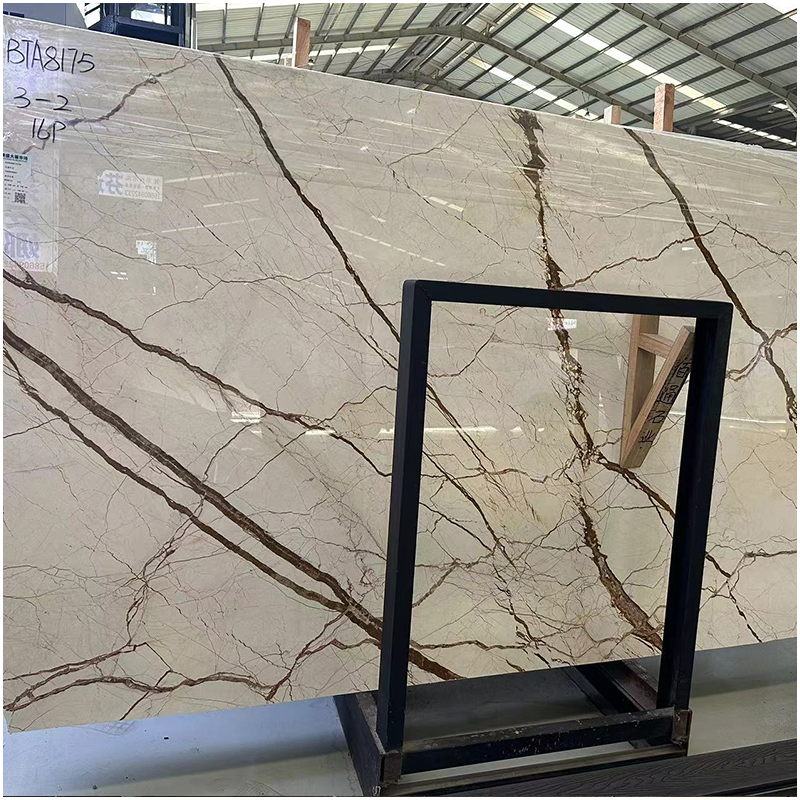Utilisation of marble
A metamorphic rock mostly made of calcium carbonate (CaCO3) is marble. Because of its great hardness, exquisite texture, and beautiful color, it finds extensive use in the domains of construction and décor. Given all of its benefits, it is a great option for both residential and commercial space design.

The marble composition
Original rock: Mostly made of biological material and detritus like marine life, corals, and shells, limestone or other carbonate rocks are the starting material for marble development.
Sedimentation: These organic materials are deposited in bodies of water, including lakes or seas, where they are compressed and gradually water is removed to produce limestone.
Geological changes: High pressures and temperatures during crustal migration lead limestone to metamorphose.
The mineral makeup, organization, and texture of limestone change during metamorphism to produce a new kind of rock known as metamorphic rock.
Rearrangement and crystallization of the calcium carbonate crystals in limestone during metamorphism create the compact structure that is exclusive to marble.
Marble’s color and texture are dictated by the mineral makeup throughout the metamorphic process as well as contaminants in the original rock.
Environmental conditions: The Paleozoic and Mesozoic age marine carbonate rock system is one of the particular geological environments needed for marble to develop.
Deposit kinds: Regional metamorphic marble, biological limestone, specific structural limestone, and dolomite marble are among the many kinds of marble deposits that may occur.
The thermal or hydrothermal actions of carbonate rock layers at the contact zone of magma intrusion create some marble deposits.
The initial limestone is eventually changed into marble with a distinctive crystal structure and brilliant luster after a protracted period of geological activity.
Compare Marble to Other Materials
An analogy with granite
A medium-hard stone, marble has a Mohs hardness of 3-5, while granite has a hardness of 6-7. Granite is thus more impact- and wear-resistant and harder than marble.
Mostly made of quartz, feldspar, etc., granite has a high silica content, excellent acid resistance, and is resistant to weathering and degradation. Both outside walls and decorations may use it. Marble, on the other hand, is mostly made of calcium carbonate and is usually advised for indoor usage since it corrodes readily by acid.
Comparative analysis of man-made marble
Because artificial marble is produced by technology, has great hardness and wear resistance, and is not readily impacted by the outside world, it is often more durable.
Though it is easy to maintain and radiation-free, artificial marble could not seem as varied and natural as actual marble.
Comparative analysis of ceramic tiles
Ceramic tiles are a reasonably priced, easily cleaned and maintained choice available in a large range of varieties. But the elegance and unadulterated feel of marble may not be found in ceramic tile.
Though it may need more upkeep and attention to keep its beauty, marble offers a more natural and distinctive look.
Analysis in relation to Slate
One novel, robust, and long-lasting material is slate. It gives modern interior and architectural design a contemporary flair.
Though maybe not as robust as slate, marble is preferred for its classical feel and timeless appearance.
Comparing to Wood:
Warm and organic in feel, wood is ideal for furnishing a cosy and friendly space. But generally speaking, wood doesn’t last as long as marble, particularly in humid or heavily used places.
Because marble is more heat and water resistant, it is appropriate for use in places like baths and kitchens.
By comparison with stainless steel:
A contemporary material ideal for kitchen counters, stainless steel is also antimicrobial and simple to clean and maintain.
The more classic and sophisticated appearance of marble requires regular sealing to avoid stains.
Maintenance and cleaning of marbles
Popular natural stone marble has to be cleaned correctly to keep its beauty and to be used for longer periods of time.
Carefully cleaning: To get rid of oil, grime, and food residues from the marble surface, use warm water and a light detergent. Use of caustic or acidic cleansers might harm the marble’s surface.
Immediately remove stains: To lessen the possibility of their seeping into the marble, dripping liquids and tough stains should be cleansed as soon as possible. If stains are very ingrained, use a specific marble stain remover.
Use hot plate cushions and mats: To avoid temperature-related fractures or damage to the marble countertop, do not set hot pots or other hot items directly upon it. Apply rubber or hot plate cushions to shield the surface.
Using cutting boards will help to preserve the marble countertop from food cuts made straight on it.
Regularly seal the pores: Marble is a porous stone that lets dirt and liquids in readily. For frequent use in lowering absorption capacity and lowering the possibility of contamination and penetration, use marble sealants.
Steer clear of hard item impact: To prevent cracks or damage, take care to keep large things from falling or striking the marble countertop.
Regular polishing of the marble surface with the right polishing product and equipment will bring back its brilliance.
For marble in busy or heavily used areas in particular, think about regular expert stone care services.
Every day maintenance: Wipe the marble with a clean, soft cloth after wiping it with a little moist towel dipped in mild detergent.
Do not cover the marble surface for extended periods of time with a damp towel or other objects in order to avoid water stains and marks.

Synopsis
Almost any aspect of life is covered by marble applications, from functional components to artistic expressions, from private areas to public events. Marble has limitless beauty and charm when used carefully and properly maintained. In addition to its utility and inherent beauty, marble is also valued historically, luxuriously, and durably. Marble may be a great option to improve quality of life and raise the worth of space provided it is maintained properly.







